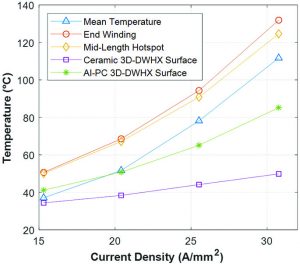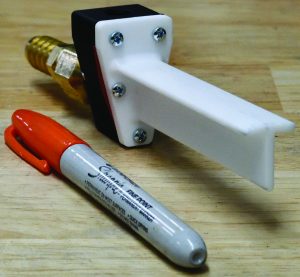Ceramic 3D Printed Direct Winding Heat Exchanger for High Ambient Temperature Operation of Electric Machines
CEME Collaborator Bulent Sarlioglu with Research Assistant William Sixel at University of Wisconsin-Madison
Increasing the power density of electric machines operating in high ambient temperatures is a challenge as all the materials involved must be rated for operation at those temperatures. To improve cooling in electric machines exposed to temperatures greater than 400°C, a 3D-printed direct-winding heat exchanger (3D-DWHX) manufactured with ceramics is investigated in this project supported by the Grainger Center for Electric Machinery and Electromechanics. The 3D-DWHX has coolant channels in close contact with the windings and is electrically insulating. Therefore, a non-dielectric coolant (such as water mixtures) can be used as coolant. The T-shaped cross-section of the 3D-DWHX cools both the windings and the stator iron. As a result, cooling performance is improved compared to the water jacket, direct oil-cooled and air-cooled methods. A prototype ceramic 3D printed direct winding heat exchanger was designed and manufactured and is shown in Figure 11. The alumina ceramic material from Ceramco can withstand temperatures of 1650°C and is therefore suitable for very high temperature electric machines.

Figure 12: Measured temperatures vs winding continuous cur-
rent density for the motorette test of the ceramic 3D-DWHX
Motorette tests are used to experimentally verify various parts of the electric machine design, and in this case refers to two slots of a stator of an electric machine used to verify the thermal design of the ceramic 3D-DWHX. The key reasons for the test are to determine whether the 3D-DWHX has good thermal contact with the windings after being encapsulated and to verify the thermal analysis of the convection enhancing internal fins. Silicone encapsulation material is used to create a good thermal contact between the 3D-DWHX and the windings. The ceramic 3D-DWHX was tested at varying current densities and shown to enable a continuous current density of 33ARMS/mm2 while keeping the winding temperature below 132°C when used with a 30°C inlet temperature coolant (see Figure 12). With its performance validated in a motorette test, the ceramic 3D-DWHX concept can now be further explored for high temperature and high power density applications.
